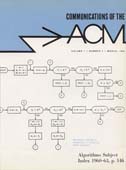March 1964 - Vol. 7 No. 3

Features
A note on some compiling algorithms
Comments on “a continued operation notation”
report on CCITT data communications study group meeting
FORTRAN subroutines for time series data reduction
Polyphase sorting with overlapped rewind
Tests on a computer method for constructing school timetables
Randomized binary searching with tree structures
Generating a canonical prefix encoding
Computer-made perspective movies as a scientific and communication tool
A technique for computer detection and correction of spelling errors
A class of iterative techniques for the factorization of polynomials
Conversion of a power to a series of Chebyshev polynomials
Digital data processor for tracking the partially illuminated moon



